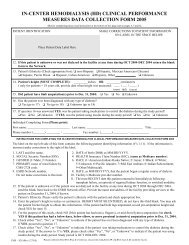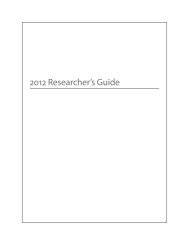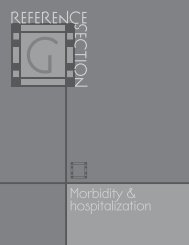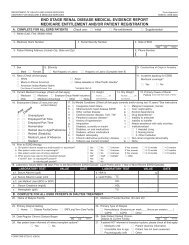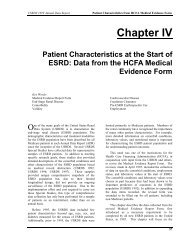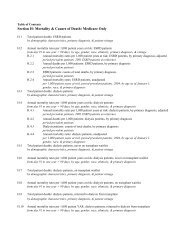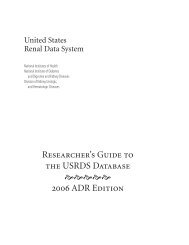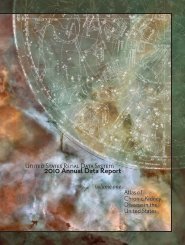2009 ADR v2 Atlas of ESRD - United States Renal Data System
2009 ADR v2 Atlas of ESRD - United States Renal Data System
2009 ADR v2 Atlas of ESRD - United States Renal Data System
Create successful ePaper yourself
Turn your PDF publications into a flip-book with our unique Google optimized e-Paper software.
5<br />
App A<br />
pg 356<br />
In this appendix we present details on the USRDS<br />
database, its standardized working datasets and<br />
specialized code definitions, and our common data<br />
processing practices. We also describe the statistical<br />
methods used in this <strong>ADR</strong>. The Researcher’s guide to<br />
the USRDS database, available online, provides additional information<br />
about the database and Standard Analysis Files.<br />
<strong>Data</strong> sources<br />
The USRDS maintains a stand-alone database with data on diagnoses<br />
and demographic characteristics <strong>of</strong> <strong>ESRD</strong> patients, along with<br />
biochemical data, dialysis claims, and information on treatment<br />
and payor histories, hospitalization events, deaths, physician/supplier<br />
services, and providers.<br />
REMIS/REBUS/PMMIS DATABASE<br />
The major source <strong>of</strong> <strong>ESRD</strong> patient information for the USRDS is the<br />
<strong>Renal</strong> Beneficiary and Utilization <strong>System</strong> (REBUS) <strong>of</strong> the Centers for<br />
Medicare and Medicaid Services (CMS, formerly HCFA), adopted in<br />
1995 as the On-Line Transaction Processing system from the previous<br />
Program Management and Medical Information <strong>System</strong> (PMMIS)<br />
database. The REBUS/PMMIS database contains demographic, diagnosis,<br />
and treatment history information for all Medicare beneficiaries<br />
with <strong>ESRD</strong>. The database has also been expanded to include<br />
non-Medicare patients, as discussed later in this appendix. Having<br />
advanced its database technology, CMS migrated the REBUS database<br />
into an Oracle relational database in the fall <strong>of</strong> 2003, including all<br />
patients who were alive and had <strong>ESRD</strong> as <strong>of</strong> January 1, 1995, or incident<br />
after this date. This database is known as the <strong>Renal</strong> Management<br />
Information <strong>System</strong> (REMIS).<br />
CMS regularly updates the REMIS/REBUS/PMMIS database, using<br />
the Medicare Enrollment <strong>Data</strong>base (EDB), Medicare inpatient and<br />
outpatient claims, the Organ Procurement and Transplantation<br />
Network (OPTN) transplant database, <strong>ESRD</strong> Medical Evidence forms<br />
(2728) provided by the <strong>ESRD</strong> networks, and <strong>ESRD</strong> Death Notification<br />
forms (2746) obtained from renal providers, as well as the Standard<br />
Information Management <strong>System</strong> (SIMS) database <strong>of</strong> the <strong>ESRD</strong><br />
networks. CMS has also established data integrity rules to ensure<br />
accurate identification <strong>of</strong> patients in the SIMS and CMS databases.<br />
Each <strong>ESRD</strong> patient is now identified with a unique patient identification<br />
number common to both databases, ensuring that data on<br />
all patients are consistently managed over time.<br />
CMS MEDICARE ENROLLMENT DATABASE<br />
The Medicare Enrollment <strong>Data</strong>base (EDB) is the designated repository<br />
<strong>of</strong> all Medicare beneficiary enrollment and entitlement data,<br />
and provides current and historical information on residence, Medi-<br />
care as secondary payor (MSP) and employer group health plan<br />
(EGHP) status, and Health Insurance Claim/Beneficiary Identification<br />
Code (HIC/BIC) cross-referencing.<br />
<strong>ESRD</strong> MEDICAL EVIDENCE FORM (CMS 2728)<br />
The <strong>ESRD</strong> Medical Evidence (ME) form is used to register patients at<br />
the onset <strong>of</strong> <strong>ESRD</strong>, and must be submitted by dialysis or transplant<br />
providers within 45 days <strong>of</strong> initiation. The form establishes Medicare<br />
eligibility for individuals previously not Medicare beneficiaries,<br />
reclassifies previously eligible beneficiaries as <strong>ESRD</strong> patients, and provides<br />
demographic and diagnostic information on all new patients.<br />
The CMS, USRDS, and renal research communities rely on the form to<br />
ascertain patient demographics, primary diagnosis, comorbidities,<br />
and biochemical test results at the time <strong>of</strong> <strong>ESRD</strong> initiation. Before<br />
1995, units were required to file the Medical Evidence form only for<br />
Medicare-eligible patients. Since the 1995 revision, however, providers<br />
are required to complete the form for all new <strong>ESRD</strong> patients.<br />
The third major revision <strong>of</strong> the ME form, released in May, 2005,<br />
was intended to remedy several shortcomings found in the 1995<br />
form and its earlier version. Key additions target pre-<strong>ESRD</strong> care and<br />
vascular access use, and additional new fields collect information<br />
on glycosylated hemoglobin and lipid testing, on the frequency <strong>of</strong><br />
hemodialysis sessions, and on whether patients are informed <strong>of</strong><br />
transplant options. This new form will help federal and private<br />
researchers gain better insights into the health and care <strong>of</strong> <strong>ESRD</strong><br />
patients prior to their entry into the program.<br />
This form is the only source <strong>of</strong> information about the cause <strong>of</strong><br />
a patient’s <strong>ESRD</strong>. Because the list <strong>of</strong> diseases has been revised, the<br />
USRDS stores the codes from each version so that detail is not lost<br />
through conversion <strong>of</strong> one set <strong>of</strong> codes to the other.<br />
<strong>ESRD</strong> DEATH NOTIFICATION FORM (CMS 2746)<br />
The <strong>ESRD</strong> Death Notification form is used to report the death <strong>of</strong> <strong>ESRD</strong><br />
patients. According to CMS policy, this form must be submitted by<br />
dialysis or transplant providers within 30 days <strong>of</strong> a patient’s death,<br />
and provides the date and causes <strong>of</strong> death (primary and secondary),<br />
reasons for discontinuation <strong>of</strong> renal replacement therapy, if applicable,<br />
and evidence <strong>of</strong> hospice care prior to death. It is the primary<br />
source <strong>of</strong> death information for CMS and the USRDS, identifying<br />
more than 99 percent <strong>of</strong> deaths. The USRDS also utilizes the Social<br />
Security Administration’s (SSA) Death Master File as a supplemental<br />
data source for ascertaining death in a small group <strong>of</strong> lost-to-followup<br />
<strong>ESRD</strong> patients; this file, however, identifies only all-cause deaths.<br />
OPTN TRANSPLANT DATABASE<br />
In the early 1980s CMS began collecting data on all Medicare kidney<br />
transplants. In 1988, the <strong>United</strong> Network <strong>of</strong> Organ Sharing (now




